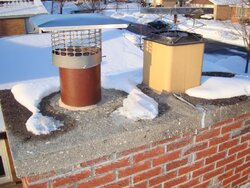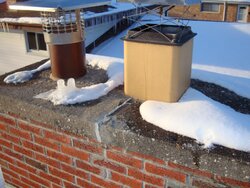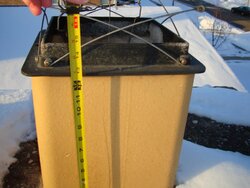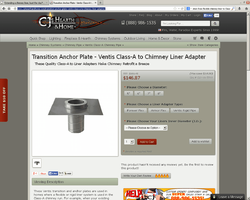Suggestions needed for extending the chimney liner (stove delivery is next week):
I have a short, external brick chimney that I will be running a smooth walled, 6" insulated stainless steel flexible liner through. The distance from top of stove to the very top of that clay flue tile (see photo) is 10 feet. That clay flue tile itself is 12 1/2" tall, 12 1/4 inches square, has a few hairline cracks (please see photo), and sits on top of a concrete chimney cap. No water gets through.
According to the stove manufacturer, I need a minimum of 12 feet of flue liner. Thus, I need to have 2 feet of flue above the top of the clay liner, or if I bust the clay liner up- I will need 3 feet above the concrete chimney cap.
I would like to keep the chimney liner insulated all the way (again, I have a short run and need all the draft help I can get).
What can I do?
Keep the clay: Should I run a flexible liner to a stainless steel clay flue chase cover, transition to a 2 foot stainless steel Class A insulated chimney liner, and then add the rain cap?
Remove the clay: Should I bust the visible clay liner up with a sledge hammer and then install a 3 foot stainless steel Class A insulated chimney liner above the flexible liner? Can I go with a 4 foot pipe? At what point do I need support braces?
Either: Can I run the flexible liner up continuously through a cheap stainless steel liner cover (no transition from flexible to hard).
I don't care what the finished install looks like, just that it drafts well and is something I can do myself to save money


 .
.
I searched and there are only a few threads about transitioning from flex to hard liner. None had a picture of an adapter or how to do it. I know I can't be the first one....
The concrete cap has two exit holes through it (one for fireplace and one for gas furnace). It is 70" by 37"
Thank you! Comments, suggestions, threats welcome!
I have a short, external brick chimney that I will be running a smooth walled, 6" insulated stainless steel flexible liner through. The distance from top of stove to the very top of that clay flue tile (see photo) is 10 feet. That clay flue tile itself is 12 1/2" tall, 12 1/4 inches square, has a few hairline cracks (please see photo), and sits on top of a concrete chimney cap. No water gets through.
According to the stove manufacturer, I need a minimum of 12 feet of flue liner. Thus, I need to have 2 feet of flue above the top of the clay liner, or if I bust the clay liner up- I will need 3 feet above the concrete chimney cap.
I would like to keep the chimney liner insulated all the way (again, I have a short run and need all the draft help I can get).
What can I do?
Keep the clay: Should I run a flexible liner to a stainless steel clay flue chase cover, transition to a 2 foot stainless steel Class A insulated chimney liner, and then add the rain cap?
Remove the clay: Should I bust the visible clay liner up with a sledge hammer and then install a 3 foot stainless steel Class A insulated chimney liner above the flexible liner? Can I go with a 4 foot pipe? At what point do I need support braces?
Either: Can I run the flexible liner up continuously through a cheap stainless steel liner cover (no transition from flexible to hard).
I don't care what the finished install looks like, just that it drafts well and is something I can do myself to save money


 .
. I searched and there are only a few threads about transitioning from flex to hard liner. None had a picture of an adapter or how to do it. I know I can't be the first one....
The concrete cap has two exit holes through it (one for fireplace and one for gas furnace). It is 70" by 37"
Thank you! Comments, suggestions, threats welcome!
Last edited by a moderator:


